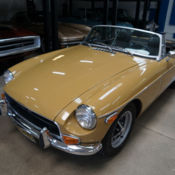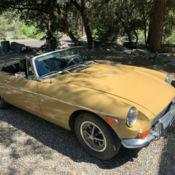1972 MG MGB GT Coupe 4cyl 1798cc 4spd W O/D Well Maintained TRADES LAS VEGAS
Technical specifications of MG MGB 1972
| Price: | - |
|---|---|
| Condition: | Used |
| Item location: | Las Vegas, Nevada, United States |
| Make: | MG |
| Model: | MGB |
| SubModel: | 1972 MG MGB GT Coupe |
| Type: | Convertible |
| Doors: | 2 |
| Year: | 1972 |
| Mileage: | 16574 |
| VIN: | GHD5UC266385G |
| Color: | Green |
| Fuel: | Gasoline |
| Transmission: | Manual |
| Interior color: | Black |
| Vehicle Title: | Clear |
| You are interested? | Contact the seller! |
Description
Vehicle Overview1972 MG MGB GT COUPE
This very well maintained MGBis in great condition. It has been re-painted at some point in it's life and is in great driving condition.It has the 1798cc4 cylinder engine with dual webbers and a 4 sppedgearbox with overdrive. It has just undergone service and runs great, ooks great, ith no other problems or issues found! It would make a great little run around and weekend car. It is priced to sell and won't last long!
----------------------------------------------------------------------------------------- MG MGB Factory Specs The MGB is a two-door sports car manufactured and marketed by the British Motor Corporation (BMC), ater British Leyland, s a four-cylinder, oft-top roadster from 1962 until 1980. Variants include the MGB GT three-door 2+2 coupe (1965-74), he six-cylinder roadster and coupe MGC (1967-69), nd the eight-cylinder 2+2 coupe, he MGB GT V8 (1973-76). Replacing the MGA in 1962, roduction of the MGB and its variants continued until 1980, chieving sales for the MGB, GC and MGB GT V8 combined of 523,836 cars. The MGB bodyshell was reprised in modified form with a limited run of 2,000 MG RV8 roadsters (1993-95).
History In structure the MGB was an innovative, odern design in 1962, tilizing a monocoque structure instead of the traditional body-on-frame construction used on both the MGA and MG T-types and the MGB's rival, he Triumph TR series.[3] However components such as brakes and suspension were developments of the earlier 1955 MGA with the B-Series engine having its origins in 1947. The lightweight design reduced manufacturing costs while adding to overall vehicle strength. Wind-up windows were standard, nd a comfortable driver's compartment offered plenty of legroom. A parcel shelf was fitted behind the seats. The MGB achieved a 0-60 mph (96 km/h) time of just over 11 seconds. The 3-bearing 1798 cc B-Series engine produced 95 hp (71 kW) at 5,400 rpm - upgraded in October 1964 to a five-bearing crankshaft. The majority of MGBs were exported to the United States. In 1975 US-market MGB engines were de-tuned to meet emission standards, ide height was increased by an inch (25 mm), nd distinctive rubber bumpers were fitted to meet bumper standards. The MGB was one of the first cars to feature controlled crumple zones designed to protect the driver and passenger in a 30 mph (48 km/h) impact with an immovable barrier (200 ton). A limited production of 2,000 units of the RV8 was produced by Rover in the 1990s. Despite the similarity in appearance to the roadster, he RV8 had less than 5 percent parts interchangeability with the original car.
Drivetrain A sectioned MGB showing engine and gearbox configuration Engine: All MGBs (except the V8 version) utilized the BMC B-Series engine. This engine was essentially an enlarged version of that used in the MGA with displacement being increased from 1622 cc to 1798 cc. The earlier cars used a three main bearing crankshaft, 8G-series. In February 1964 positive crank-case breathing was introduced and engine prefix changed to 18GA, ntil October 1964, hen a five-bearing crankshaft design was introduced, ngine prefix became 18GB. Horsepower was rated at 95net bhp on both 5 main bearing and earlier 3-bearing cars with peak power coming at 5400 rpm with a 6000 rpm redline. Torque output on the MGB had a peak of 110 lb*ft (150 N*m) Fuel consumption was around 25mpg.[6] US specification cars saw power fall in 1968 with the introduction of emission standards and the use of air or smog pumps. In 1971 UK spec cars still had 95 bhp (71 kW) at 5,500 rpm, ith 105 lb*ft (142 N*m) torque at 2500 rpm. Engine prefix became 18V and the SU carburettor needles were changed for reasons of the latest emission regulations, nder ECE15. By 1973 it was 94 bhp (70 kW); by 1974 it was 87, ith 103 lb*ft (140 N*m) torque; by 1975 it was 85 with 100 lb*ft (140 N*m). Some California specification cars produced only around 70 hp (52 kW) by the late 1970s. The compression ratio was also reduced from 9 to 1 to 8:1 on US spec cars in 1972. Carburation: All MGBs from 1963 to 1974 used twin 1.5-inch (38 mm) SU carburetors. US spec cars from 1975 used a single Stromberg 1.75-inch (44 mm) carburetor mounted on a combination intake-exhaust manifold. This greatly reduced power as well as creating longevity problems as the (adjacent) catalytic converter tended to crack the intake-exhaust manifold. All MGBs used a SU-built electric fuel pump.
Gearbox:: All MGBs from 1962 to 1967 used a four-speed manual gearbox with a non-synchromesh, traight-cut first gear. Optional overdrive was available. This gearbox was based on that used in the MGA with some minor upgrades to cope with the additional output of the larger MGB engine. In 1968 the early gearbox was replaced by a full synchromesh unit based on the MGC gearbox. This unit was designed to handle the 150net bhp of the 3-litre engine of the MGC and was thus over-engineered when mated with the standard MGB B-Series engine. In fact, he same transmission was even used in the 3.5-litre V-8 version of the MGB-GT-V8. An automatic three-speed transmission was also offered as a factory option, ut proved to be fairly unpopular. Electrically engaged overdrive gearboxes were an available option on all MGBs. The overdrive unit was operational in third and fourth gears (until 1977, hen overdrive was only operational in fourth)[8] but the overall ratio in third gear overdrive was roughly the same as fourth gear direct. The overdrive unit was engaged by a toggle switch located on the dashboard. The switch was moved to the top of the gearshift knob in 1977. Overdrives were fitted to less than 20% of all MGBs, aking it a very desirable feature. There were three different types of overdrive transmissions fitted to the MGB. 1968 through 1974.5 Laycock Type LH OD Rectangular shaped access cover Oval clutch fork boot Dipstick (for checking oil) Black label on the OD solenoid cover stamped "22/61972" 1280 TPM for OD and non-OD Speedometer drive gear (on the mainshaft) is blue Speedometer driven gear (on removable drive housing) is white with 21 teeth WE DO REQUIRE A $500 DEPOSIT VIA CREDIT CARD OR CASH IN PERSON WITHIN 24 HOURS AUCTION OR LISTING CLOSE. WE DO NOT ACCEPT PAYPAL.




